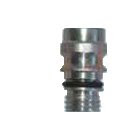Why Can’t I Get This Schrader Valve Out?
A guy came into the store the other day wanting to purchase a new hose or have us fix his old one.
Looking at the hose I asked “What’s wrong with it?”
“It leaks right here at the valve” and he pointed towards the hoses R134A high side access port.
“So why don’t you change the schrader valve?”
“I can’t. It doesn’t come out……Never saw such a stupid design……The @@##$#% want you to buy a new hose instead of changing the schrader valve.”
I picked up the hose and looked at the high side access port. As I suspected, it had a what is called a primary port adapter……and before you ask, I have no idea why they named it that because there is nothing primary about it and it doesn’t work as an adapter for anything. Its’ only purpose is that for which it was apparently intended, to make something simple complicated and convoluted. Pi ctured here is a GM high side Primary Port Adapter. You can identify it by the fact that the schrader valve is non removable. When you look into the opening of the port instead of seeing a pin type depressor with a shoulder that can be turned with a standard schrader valve removal tool, you will see a round plastic ball type depressor that cannot be turned or removed. Also, notice that above the oring there is a lip of sorts. This lip mates almost seamlessly with the female threaded housing in the hose, making it appear to be one piece and non removable. Because of this, and because we are used to dealing with easily removable schrader valves, ones’ initial reaction is there is no way to fix the leak and therefore you must replace the hose…..a very pricey error to make.
ctured here is a GM high side Primary Port Adapter. You can identify it by the fact that the schrader valve is non removable. When you look into the opening of the port instead of seeing a pin type depressor with a shoulder that can be turned with a standard schrader valve removal tool, you will see a round plastic ball type depressor that cannot be turned or removed. Also, notice that above the oring there is a lip of sorts. This lip mates almost seamlessly with the female threaded housing in the hose, making it appear to be one piece and non removable. Because of this, and because we are used to dealing with easily removable schrader valves, ones’ initial reaction is there is no way to fix the leak and therefore you must replace the hose…..a very pricey error to make.
Replacement and removal of these ports is quite simple. First you must remove all of the freon from the system. Be absolutely certain you have all of the freon out of the system and there is no pressure in it. Failure to do so could cause serious injury or death. The port can violently shoot out of its housing with the force of a bullet releasing freon and oil with it.
Once you are sure there is no pressure in the system, simply use the appropriate sized wrench or socket on the port while holding its’ female base (the part in the hose) with a second wrench. This is very important because if the threads bind you will turn the housing instead of the threads and possibly ruin the hose.
Next clean the housing threads, put a little bit of oil on the oring, insert the port into the housing and turn it by hand as far as it will go or until the oring seats. Then snug it up using the two wrenches as described above until the gap above the oring disappears and it once again gives the illusion of being one piece.
Remember, this is an oring seal and does not need to be tightened with super human strength. Once the oing is seated it will seal and hold pressure. The ONLY reason to use a wrench is to tighten it enough that it won’t vibrate loose.
That’s it. The repair is complete!
I hope this saves some of you a bit of grief should you encounter this.
Until the next time, thanks for reading.
Joe

